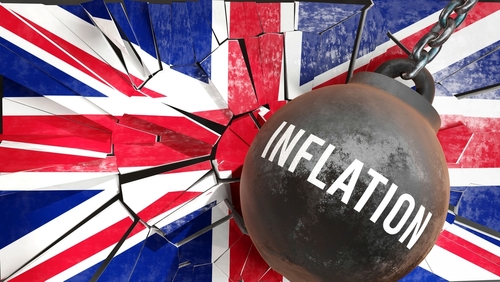
Monetary Policy & Inflation | Rates | UK

Monetary Policy & Inflation | Rates | UK
This article is only available to Macro Hive subscribers. Sign-up to receive world-class macro analysis with a daily curated newsletter, podcast, original content from award-winning researchers, cross market strategy, equity insights, trade ideas, crypto flow frameworks, academic paper summaries, explanation and analysis of market-moving events, community investor chat room, and more.
The UK is in trouble. This Friday, Ofgem will announce a rise in household energy bills of 80%. Annual energy bills for households are expected to rise above £3,600. In January, it is forecast to top £5,380.
UK households are already cutting back on spending. They have been doing so since the start of 2021. This is bad for the economy, but more importantly it shows the considerable strain that individuals are under to make ends meet. Real wage growth has been significantly negative since the start of the year, and real retail sales are being crushed (Chart 2).

The inflation is hurting. So why is the Bank of England not keener to hike until it stops? They were forecasting >11% Q4 inflation in May, yet were content to hike in 25bps clips, with two MPC members consistently dragging their feet on even that.
One reason for this is the delayed effect of interest rate policy on inflation – estimated at around 18 months by External MPC Member Silvana Tenreyro. The BoE can only affect inflation by making credit more expensive. But this will place another heavy weight on already beleaguered households. That is why the BoE has instead tried to focus (with mixed results) on the risk of a medium-term ‘wage-price spiral’. That is, the risk that rising costs drive individuals to request faster wage growth, which then drives faster price growth (and so on).
The question is, in the current environment, will raising interest rates prevent a wage-price spiral, or exacerbate it?
As a purely illustrative example, we take an average UK individual and compare their situation in June 2019, June 2022, and June 2023 (Charts 3, 4 and 5).
For simplicity, we assume they live in a household of one, and that they are about to refinance their mortgage (mortgages are the biggest debt most consumers will hold at c.£130,000 on average, with roughly a quarter of mortgages re-financed each year).

Based on national averages and our calculations, we see that in 2019 individual’s finances looked pretty healthy. With a median gross salary of £1,800pm, our individual pays c.£540pm in tax (income and council), £105pm on household energy, £280pm on food, £80pm on petrol, £360pm on other retail items, and £213pm on their newly refinanced mortgage (5Y fix, 75% LTV at 1.97%). This leaves a healthy saving amount of c.13%.
Note: this is decently above the 5% ONS estimate of savings rate at that time, which is because our estimate omits automobile purchases, the cost of credit cards, etc., (our individual only has a mortgage), and the cost of any additional dependents such as children.
Fast forward to 2022, and the situation has deteriorated. Median income has risen by 16%, but other costs have risen faster. The tax burden has dropped, but food, petrol and other spending has increased 3pp as a proportion of gross income. This is entirely a price effect and overwhelms the fact that the volume of goods bought (real spend) has dropped since 2019. Meanwhile, the rise in the mortgage rate (then 2.9%) leaves our individual with just 5% to save.
Finally, we find ourselves in 2023: incomes have grown, but saving is no longer an option. The rise in energy prices is now truly biting (as per Chart 1); it now consumes a full 13% of gross income. Meanwhile, even assuming no change in amounts purchased, our individual finds themselves paying almost 10% more on their shopping (BoE estimate of CPI). Finally, assuming the BoE has hiked in line with market prices, their newly refinanced mortgage rate is now just below 5%, leaving a 14% (£300pm) overshoot in spend (Chart 5). In such a scenario, the mortgage rate would need to fall by 0.5pp for our individual to break even.
The shortfall will need to be made up by savings or borrowing. By ONS calculations, pre-pandemic only half of people had savings greater than £5,000. For younger people it was only a third. This suggests that credit will need to cover the shortfall. Historic data tells us this tends to be the case (Chart 6). The outlook looks particularly bleak there. While typically an acceleration in consumer credit growth would coincide with low borrowing rates, right now interest rates on credit cards are at 20-year highs (Chart 7).

The culmination is a situation whereby further rises in the bank rate add fuel to the cost-of-living crisis, increasing households’ need to borrow and with it their exposure to rising interest rates. In such a situation, it seems hard to argue that employee demands for faster wage growth will fall away. Instead, it seems more likely that pressure will only build. The counterargument may be that a recession and rising unemployment will reduce the capacity to demand pay rises, but this is not currently shown in BoE forecasts. Even in their recession scenario, the BoE expect unemployment to barely rise 1pp.
Spring sale - Prime Membership only £3 for 3 months! Get trade ideas and macro insights now
Your subscription has been successfully canceled.
Discount Applied - Your subscription has now updated with Coupon and from next payment Discount will be applied.